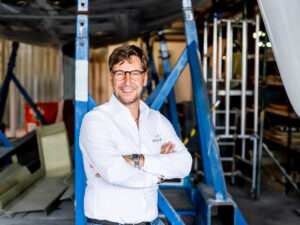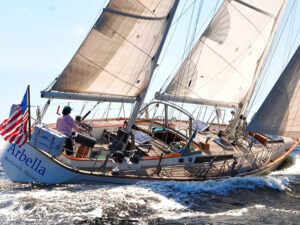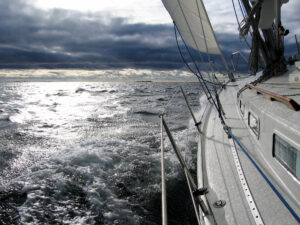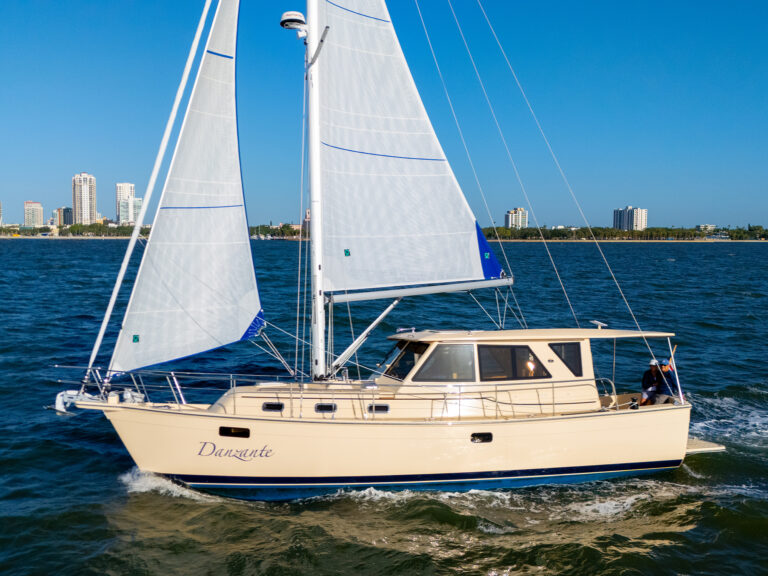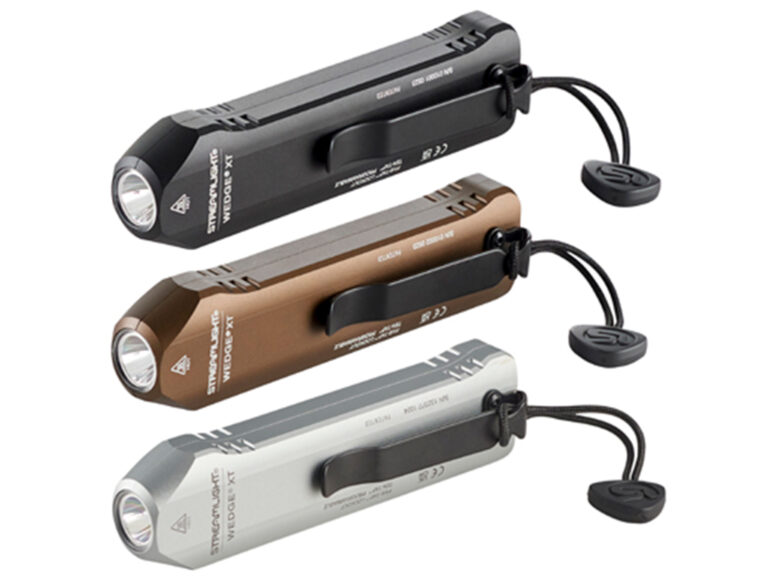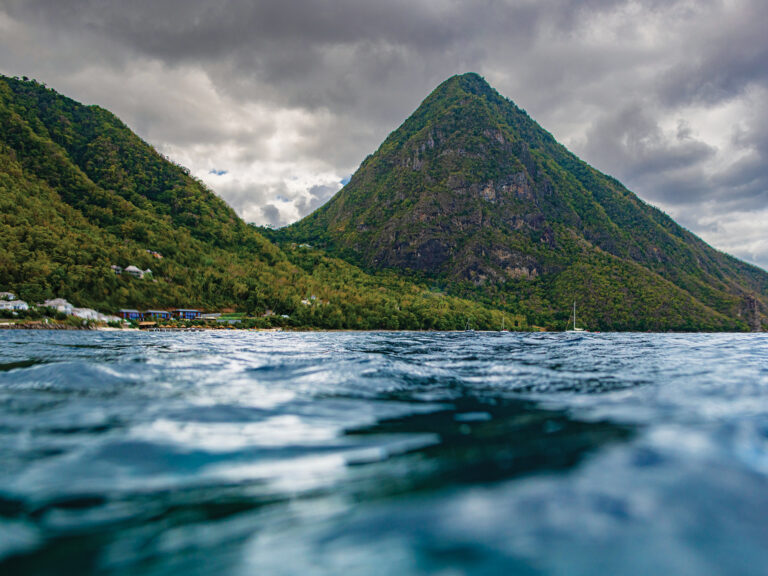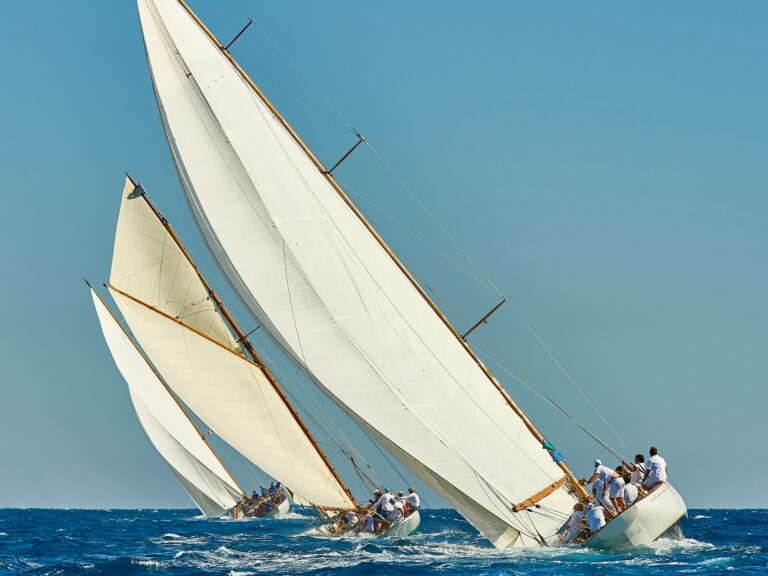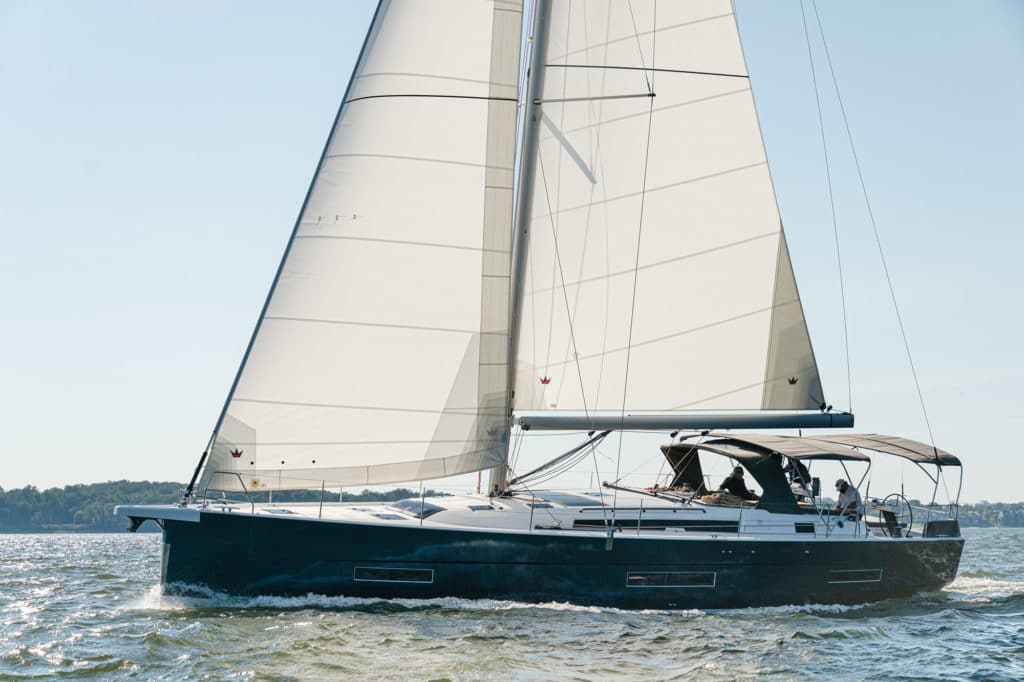
Like clockwork, each fall for the past decade or so, Dufour Yachts has arrived in Annapolis, Maryland, with a new sailboat (or sometimes two) that somehow looks remarkably just like its predecessor—only different.
One year, the builder introduced the galley-forward concept, which puts the stove, sink, fridges, and counterspace adjacent to the mast and bulkhead, leaving the widest part of the boat open for entertainment and lounging. Another year, large ports in the cabin top over the forward galley were added to let light pour into the interior. One fall, they made a splash with an outdoor galley built into the transom, where a propane grill and sink can be put to good use by a cook standing on the fold-down swim platform while still being part of the party. These features not only were incorporated in subsequent models, some are now being copied by other builders as well.
But then came fall 2020, which was notably different from other years in so many ways, not the least of which was the cancellation of the US Sailboat Show—the coming-out party, if you will, for new models introduced to the North American market. But still, Dufour, now under the direction of the Fountaine Pajot Group, sailed into town with yet another new Grand Large—the 530—that continues the evolution of the company’s nine-boat range.
The lineup’s DNA is not by happenstance. For more than 15 years, Dufour has relied solely on Umberto Felci of Felci Yacht Design and the team back at the Dufour yard in France.
As well as a resemblance among models, this long-term collaboration has had one more benefit: The Dufours all sail like proverbial witches, thanks to Felci’s very slippery hulls and sail plans to make them scoot.
The 530 bears the same plumb bow and stern as its siblings, an easily recognizable low-profile cabin house, ample beam carried all the way aft, and a single rudder—the latter almost in defiance of the twin foils that are quite the rage these days. Below, the boat’s galley is forward with large ports overhead which, along with multiple hatches in the owner’s cabin forward, plus three long ports in either side of the hull, let in tons of daylight and provide lovely views of the great outdoors. And yes, this Dufour has—as do all—the trademark wine cellar beneath the saloon sole, and a lift-up cover over a crumb tray in the galley to make sweeping up easier.
Still, the 530 is, indeed, different, primarily due to a few new features introduced in the cockpit. So let’s start there. First and foremost is the simple solution they’ve found to solve the age-old sailboat conundrum: how best to move from the cockpit to the deck, a challenge compounded by the contortions needed to dodge Bimini and dodger frames while stepping up and over coamings. Just forward of the 530′s twin wheels, designers have placed a step between the helms and the cockpit seats. As noted: simple. Up one step and you’re on deck. And the risers do double duty as line-storage bins with lift-up lids, right below the cockpit winches. Designers then further refined this solution by adding a split Bimini so crew doesn’t need to duck or dodge when going forward.
With a little more than 16 feet of beam, there’s a fair amount of space between the helms, a portion of the transom that on most boats goes unused. On catamarans, this space is often put to good use with a bench, where one can sit and enjoy the ride. And it is here that designers added a large sun bed, and they did it in a way that still allows an easy passage from wheel to wheel when underway. I liked it.

The remainder of the cockpit is fairly straight-forward, with a large, fixed drop-leaf table between the seats, allowing for plenty of room to either side when moving forward to the companionway.
Wide side decks make it easy to move about the topsides. Forward of the mast, the cabin top tapers quickly to a broad foredeck that would be a pleasant place to stretch out and enjoy the breeze at anchor. There’s also a large sail locker that provides access to both the thruster below and the big anchor locker (which can also be fit out as a skipper’s cabin). The bow sprit does double duty as a place to stow the anchor and tack down off-wind sails.
Speaking of sails, when purchasing a 530, there are decisions to make, starting with rigging and sail-handling hardware. The Easy version comes with a self-tacking jib, and all lines are led to clutches and a winch at each helm, leaving the cabin top by the companionway free of clutter.
The Ocean package adds a winch to either side of the companionway, and that’s where halyards, vang, and reef and furling lines are led.
Both of these versions include a traveler that spans the cabin top forward of the companionway; the rigs can be configured with either conventional or in-mast furling mains, and either a self-tacking or slightly overlapped genoa, the latter with fairleads that can be adjusted from the cockpit.
A Performance version for regatta-prone skippers is also available. Rather than midboom sheeting, the mainsheet is anchored to the cockpit floor just ahead of the helms; there are six winches to handle main, genoa and downwind-sail control lines; backstay and vang are hydraulic; and the mast and boom are lengthened to provide roughly 215 more square feet of sail area.
The 530 we sailed during Boat of the Year sea trials this past fall was set up with an in-mast furling main and genoa. Personally, I’d have gone for the conventional main with a boom pouch, but still, we had a great time out on the water. In 10 to 12 knots of breeze, we skipped along at just under 8 knots closehauled, and hit a solid 8 peeling off to a beam reach. In one near-20-knot puff, I saw 9.3 on the speedo—not too shabby for a roomy cruiser.
Below, the galley forward allows ample room for a large dining table to port, with seating for eight or more thanks to a centerline bench. There’s a settee opposite with an aft-facing nav station at its end.
Counters in the galley are Corian, including a backsplash to protect the bulkhead. There’s plenty of storage and fridge and freezer space, and lots of room for a cook and helper to prepare meals.
An owner’s cabin is forward, with room to either side of the queen-size berth. In the configuration we saw, the head and shower compartments were separated.
There are multiple layouts available, depending on how many crew you like to sail (or charter) with. The basic layout is three cabins, three heads. On the boat we sailed, the starboard head was replaced by a fourth cabin with bunks. Up to six cabins are possible.
The price of the Dufour we sailed—delivered, commissioned and ready to go—was $550,000. For that you get a lot of options from which to choose, and remember, a witch to sail.
Mark Pillsbury is CW’s editor.
SEA TRIAL
WIND SPEED: 10 to 12 knots
SEA STATE: 1- to 2-foot waves
SAILING: Closehauled 7.9 knots; Reaching 8.0 knots
MOTORING: Cruise (1,900 rpm) 5.9 knots; Fast (2,600 rpm) 7.4 knots
SPECIFICATIONS
LENGTH OVERALL: 53′6″ (16.31 m)
WATERLINE LENGTH: 50′10″ (15.49 m)
BEAM: 16′4″ (4.98 m)
DRAFT: 7′6″ (2.29 m)
SAIL AREA (100%): 1,518 sq. ft. (141 sq. m)
BALLAST: 13,361 lb. (4,700 kg)
DISPLACEMENT: 35,706 lb. (16,196 kg)
BALLAST/DISPLACEMENT: 0.29
DISPLACEMENT/LENGTH: 121
SAIL AREA/DISPLACEMENT: 22.4
WATER: 195 gal. (738 L)
FUEL: 116 gal. (439 L)
HOLDING: 26.4 gal. (100 L)
MAST HEIGHT: 75′2″ (22.9 m)
ENGINE: 75 hp Volvo, Saildrive
DESIGNER: Felci Yacht Design/Dufour Design Team
PRICE: $550,000
For more information, visit: dufour-yachts.com


